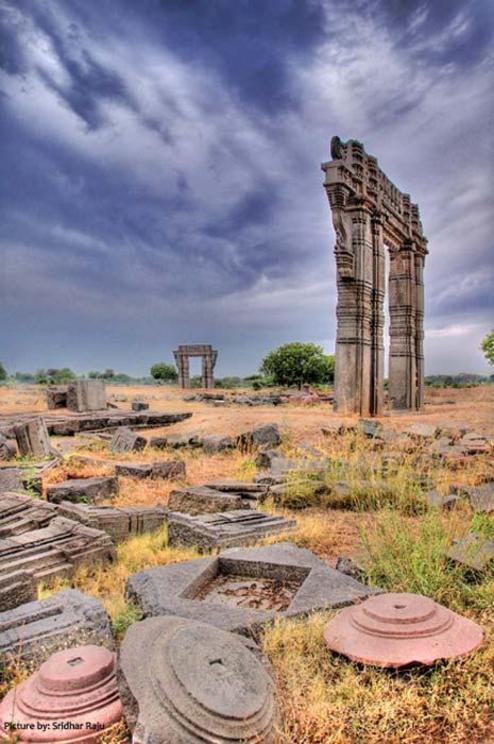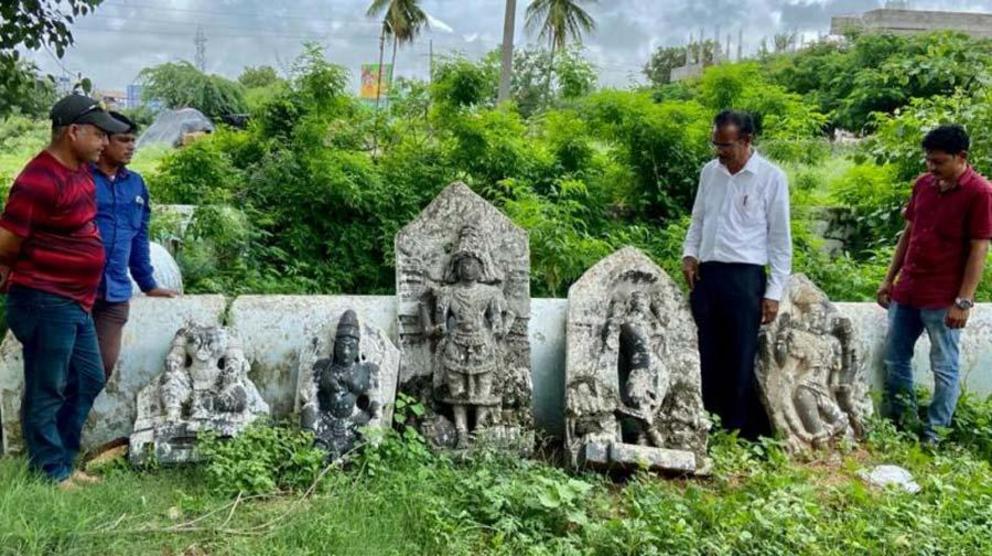800-year-old Kakatiya dynasty statues found abandoned near Indian temple
Top image: Cluster of 13th century Kakatiya Dynasty sculptures found at Duddeda village in Siddipet district by New Telangana History Group.
In the village of Duddeda in the southern Indian province of Telangana, amateur historians stumbled upon an astounding collection of ancient statues dating from the Kakatiya Dynasty, the Deccan Chronicle reported
While exploring the grounds of a local temple, representatives of the New Telangana History Group (NTHG) found a severely neglected set of five religious statues, clustered together near a crumbling old water tank. Even though the statues were in bad shape, it was clear to the NTHG members that they were finely crafted objects of art that had been made by a skilled artist.
Determined to find out more about the statues’ meaning and antiquity, the NTHG members reported their discovery to the Cultural Centre of Vijayawada and Amaravati in the southern Indian state of Andhra Pradesh . They were put in touch with Cultural Centre CEO Dr. E. Siva Nagireddy, an accomplished archaeologist with advanced knowledge about the ancient history of southern India.
Dr. Nagireddy visited the site to see for himself what the amateur historians had found. He quickly identified the figures on the statues as those of important Hindu gods . Two of the statues contained the carved images of the mother goddess Devi, while the other three statues featured images of Chennakesava ( Vishnu), Venugopala ( Krishna), and Bhairava (the son of Shiva).
 Shaktism goddess Devi is represented in two of the statues.
Shaktism goddess Devi is represented in two of the statues.
But what was most exciting about the statues was their time of origin. Their distinctive artistic style revealed them to be products of the Kakatiya Dynasty , an arts-loving empire that ruled the territory currently occupied by the states of Telangana and Andhra Pradesh from 1163 to 1323.
Specifically, these statues were created in a style that was typical of 13th and 14th century Kakatiya Dynasty art. Based on previous discoveries, Dr. Nagireddy determined they were made during the kingship of the last Kakatiya Dynasty ruler, Prataparudra II, who occupied the throne from 1295 to 1323.
Like so many other Kakatiya Dynasty leaders, Prataparudra II was a great patron of the arts, and specifically of religious art that honored the most important Hindu gods. Kakatiya Dynasty art flourished during his reign, which was tragically cut short when the dynasty was destroyed by outside invaders.
 The ruins of the Kakatiya fort from 12-13th century.
The ruins of the Kakatiya fort from 12-13th century.
The Rise and Fall of the Kakatiya Dynasty
In the beginning, the Kakatiya Dynasty was not a dynasty at all. It was a small kingdom that ruled a section of what is now the southern Indian state of Telangana, starting in approximately the year 800. For more than 300 years, the Kakatiya state was controlled by more powerful states, including the Western Chalukyas Empire .
But in 1163 that all changed. The first true leader of the Kakatiya Dynasty, Pratapurada I, seized power in the Telangana region by defeating other small states affiliated with the Western Chalukyas Empire. He then incorporated those states into his new kingdom, treating them well enough to ensure they would remain loyal to his rule.
The most influential and successful of the Kakatiya kings was Ganapati, who ruled the kingdom for an amazing 63 years (1199 to 1262). Ganapati dramatically expanded the territory of the Kakatiya Dynasty, essentially uniting the entire Teluga-speaking region of southern India under the umbrella of his empire.
The empire continued to dominate the region under the rule of Ganapati’s daughter, Rudrama, who had the distinction of being the only queen to lead the Kakatiya Dynasty. When Rudrama was succeeded by Pratapurada II, no one in the kingdom had any reason to suspect the end was near, as the dynasty was seemingly at the height of its power and still had the support of its people.
But in the early 14th century, the Kakatiya Dynasty was targeted for destruction by an even more powerful neighbor—the Delhi Sultanate . This rapidly expanding Islamic empire swept across the Indian subcontinent in the 13th century, and once the Sultanate turned its sites on Kakatiya lands the final result was inevitable. The forces of Pratapurada II resisted admirably for several years, but were finally conquered by the Sultinate in 1323.
Under foreign rulership, the Telugu-speaking region experienced a steep decline in its fortunes. Peoples who were once united under Kakatiya Dynasty leadership split apart, as the overall situation dissolved into chaos. Patronage for the arts ended, thus bringing to a close an era that had produced spectacular architectural projects , majestic temples to the Hindu gods, many beautiful statues, and a renewal of interest in ancient Sanskrit literature.
 Famous ruins of the Kakatiya Kala Thoranam or Warangal Gate.
Famous ruins of the Kakatiya Kala Thoranam or Warangal Gate.
Reminders of a Glorious Time
The reign of the Kakatiya Dynasty is recognized as one of the most glorious periods in southern Indian history. While art was encouraged, dynasty kings ruled fairly and justly, promoting egalitarianism over a rigid caste system. As a result, the dynasty had the widespread support of its population.
Dr. Nagireddy has remained in the village where the statues were found, speaking to local citizens about their significance and telling them more about the skills of Kakatiya sculptors, and about the accomplishments of the Kakatiya Dynasty as well. He is asking the Indian government to take steps to preserve and protect the statues, which clearly have tremendous historical value.

